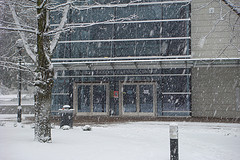
We would like to wish you happy holidays! We are looking forward to work with many of you next year!
Enjoy the snow 🙂
** Photo by velkr0

We would like to wish you happy holidays! We are looking forward to work with many of you next year!
Enjoy the snow 🙂
** Photo by velkr0
Environment Canada operates the National Climate Data and Information Archive. The Archive contains the official climate and weather observations for Canada.
Direct access to climate and weather values in the database is available at Climate Data Online. Use this area to find out what the weather was like on a particular day, for a month, or for a whole year.
The Canadian Climate Normals contain averages and extremes for nearly 1,500 locations across Canada. Use this area to find out about the conditions usually found at a location at different times of the year.
Canadian Daily Climate Data (CDCD). The 2006/7 CDCD containing daily temperature, precipitation and snow-on-the-ground data is available for download.
Data files can be download in CSV or XML format for further analysis.
Submitted by Kevin Lindstrom, Liaison Library for Earth and Ocean Sciences
Interested in what’s going on at Google? There are a number of ways of doing this. Going to Google Labs will show you some of their cool new technologies.
What else is going on at Google? Searching the ACM Digital Library for Google in the Affiliations field retrieves 359 papers. The most recent being Programming the Intel 80-core network-on-a-chip terascale processor. A paper presented at the of the 2008 ACM/IEEE Conference on Supercomputing held in Austin, Texas.
Another good database to look at is Compendex. Repeating the same affiliation search in Compendex retrieves 278 papers. The most recent article in Compendex is A New Baseline for Image Annotation published in Springer Lecture Notes in Computer Science, volume 5304, pages 316-329, 2008.
Okay. Let’s look at how Google protects its intellectual property. A search of the Google Patents database for Google in the assignee name field retrieves 100 patents/patent applications with the most recent US patent 7,352,833 Method and System for Temporal Autocorrelation Filtering being published on May 8, 2008.
Repeating the same search in Espacenet retrieves over 1675 patents/patent applications with most recent patent/patent application US 20080301093 A1 Determining Search Query Statistical Data for an Advertising Campaign Based on User-Selected Criteria published on December 4, 2008.
Okay, here’s the challenge. Use Google Scholar find the most up-to-date recent articles, patents/patent applications written by researchers at Google. Let me know what you find and how easy it was.
Moral of the story. There is something to be said for databases such as Compendex, Web of Science and Scifinder Scholar that index thousands of journals and conference proceedings and have sophisticated search interfaces that allow you – the end user to find exactly what you are looking for.
Submitted by Kevin Lindstrom Kevin Lindstrom Liaison Librarian for Electrical and Computer Engineering, Earth and Ocean Sciences, Chemistry and Chemical Engineering, Materials Engineering, Physics and Astronomy, and Physical Geography.
Impact factors, Journal Citation Reports, the Science Citation Index and its online version the Web of Science are all statistical measures of the importance of journals and of the researchers who publish in them.
There are in fact journals that specialize in bibliometrics – the journal Scientometrics is one such example.
Dr. Jorge Hirsch, a physicist at UC San Diego has taken the “times cited” measure one step further by proposing the h-index “defined as the number of papers with citation number >h, as a useful index to characterize the scientific output of a researcher.”
Does the h index have predictive power? Hirsch, J. E. Department of Physics, University of California at San Diego, La Jolla, CA, USA. Proceedings of the National Academy of Sciences of the United States of America (2007), 104(49), 19193-19198.
Bibliometric measures of individual scientific achievement are of particular interest if they can be used to predict future achievement. Here we report results of an empirical study of the predictive power of the h index compared with other indicators. Our findings indicate that the h index is better than other indicators considered (total citation count, citations per paper, and total paper count) in predicting future scientific achievement. We discuss reasons for the superiority of the h index.
Using the Web of Science database, h-indexes can also be calculated for individual departments . For example, here’s the h-index numbers for a select number of Canadian university electrical engineering departments:
TORONTO 89
UBC 54
MCGILL 53
ALBERTA 51
The folks at Thomson Reutershave put together a short but very information video on impact factors and how to use the Web of Science database to find your own h-index.
Submitted by Kevin Lindstrom Liaison Librarian for the Physical and Appled Sciences, University of British Columbia
Researchers from the Departments of Geography and Earth and Ocean Sciences have used the Celebration of Light Fireworks Competition as an opportunity to model plume trajectory, plume height and spread, and vertical dispersion.
Lidar ceilometer observations and modeling of a fireworks plume in Vancouver, British Columbia. Atmospheric Environment, Volume 42, Issue 30, September 2008, Pages 7174-7178 Derek van der Kamp, Ian McKendry, May Wong, Roland Stull.
Abstract
Observations of a plume emanating from a 30-min duration pyrotechnic display with a lidar ceilometer are described for an urban setting in complex, coastal terrain. Advection of the plume across the ceilometer occurred at a mean height of 250 m AGL. The plume traveled downwind at approx 3 m/s, and at a distance of 8 km downwind, was approx 100 m in vertical thickness with particulate matter (PM) concentrations of order 30–40 mg/m^3. Surface PM observations from surrounding urban monitoring stations suggest that the plume was not mixed to ground over the urban area. Plume trajectories at approx 250 m simulated by three numerical models all traveled to the northeast of the ceilometer location. Horizontal plume dispersion estimates suggest that the model trajectories were too far north to accommodate the likely lateral plume spread necessary to explain the ceilometer observations. This poor agreement between near surface observations and model output is consistent with previous mesoscale model validations in this region of complex urbanized terrain, and suggests that despite improvements in mesoscale model resolution, there remains an urgent need to improve upstream initial conditions over the Pacific Ocean, data assimilation over complex terrain, the representation of urban areas in mesoscale models, and to further validate such models for nocturnal applications in complex settings.
Submitted by Kevin Lindstrom Liaison Librarian for Physical Geography and Earth and Ocean Sciences

Now after the election, it would be interesting to see whether Senator Obama will perform on the science and technology issues his campaign has promised.
Here is Obama’s platform on STM issues, accumulated by the American Association for the Advancement of Science – http://election2008.aaas.org/comparisons/obama.shtml
Do you notice something of a particular interest to you?
** Photo by jmtimages

A technology report (PDF) by a Harvard University student shows that of all the digital tools that professors use, Harvard students find most useful online course material and syllabi.
The report said students want courses to have a Web site that contains readings, notes and other content so they can be accessed easily during the semester. The survey is based on responses last December from 328 undergraduates and 120 graduate students.
Is it the same with our UBC folks? Does it ring any bells for our faculty?
** Photo by AdamLogan

Released in June 2008 by Thomson Reuters (formerly ISI), this list shows the top ten nations ranked according to output of published journal articles in 22 main fields of science (including general social sciences), based on papers indexed by Thomson Reuters (excluding books, book chapters, and articles published in non-Thomson Reuters-indexed journals) between January 1998 and February 29, 2008.
http://sciencewatch.com/dr/sci/08/jun15-08_1/
** photo by 427
We’ve got ebooks on almost any topic under the sun and pdf’s are a lot lighter to carry than paper.
You want books on how to write code in Python or how to fix your new laptop running Microsoft Vista? Have a look at the Books 24X7 IT Collection.
Trying find some good stuff on biodiesel? Heres’ a hot title
Biodiesel – A Realistic Fuel Alternative for Diesel Engines
Need some physical property data like the viscosity of Cl2 gas? A search of Knovel.com will link you to the Chemical Properties Handbook and Yaws’ Handbook of Thermodynamic and Physical Properties of Chemical Compounds
Need some good information on climate change? Here’s a good starting point Assessing Climate Change.
Circuit diagrams for operational amplifiers? Check out the Electrical Engineering Handbook.
All in all, you have access to more than five thousand science and engineering ebooks.
For a complete list (not including Books24X7 titles) go to the Science & Engineering Ebook site. There you can find A-Z titles lists of ebooks as well as the search interfaces for the ebook collections you have access to. Make sure you look at the Springer Ebooks as well. Springer is a major science and engineering publisher.
Remember that these resources are not freely available on internet, so if you are connecting from off campus, go to UBC’s VPN site for instructions.
Posted by Kevin Lindstrom Liaison Librarian for Earth and Ocean Sciences, Chemistry and Chemical Engineering, Electrical and Computer Engineering, Materials Engineering, and Physics.
PRO/UAW, the union that tried and failed in 2006 to organize the postdocs on the 10 University of California (UC) campuses, has received official notification that it succeeded on its second try. On 19 August, the California Public Employment Relations Board (PERB) faxed a letter to the organizers stating that the union, known formally as Postdoctoral Researchers Organize/International Union, United Automobile, Aerospace and Agricultural Implement Workers of America, had submitted valid signatures from a majority of the approximately 5000 UC postdocs eligible to petition for union representation. Under state law, unionization is therefore automatic. The move brings an estimated 10% of U.S. postdocs into UAW, an AFL-CIO-affiliated national union that represents more than a million other members, including UC academic employees, such as graders, teaching assistants, and lecturers.
Read the full article at here
Submitted by kevin lindstrom Science and Engineering Liaison Librarian
UBC Library
Info:
604.822.6375
Renewals:
604.822.3115
604.822.2883
250.807.9107